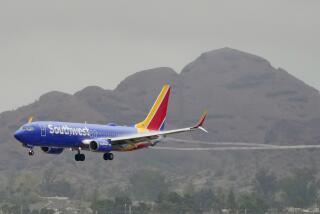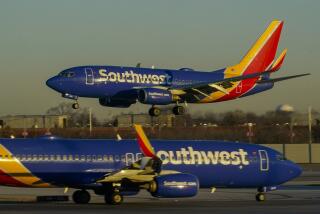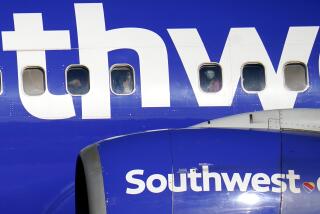Northwest Will Ban Smoking on U.S. Flights
NEW YORK — Northwest Airlines said Wednesday that it will ban smoking on all of its domestic flights, becoming the first major U.S. airline to do so.
The rule will go into effect April 23, the same day that cigarette smoking will be prohibited on all U.S. airline flights of two hours or less under a new federal regulation. Cigar and pipe smoking have not been allowed on U.S. airliners since 1979.
California banned all smoking on flights within the state earlier this year.
Northwest, headquartered in Minneapolis, is the nation’s fifth-largest air carrier. It serves 220 cities in 20 countries and in 1987 carried 37.2 million passengers. It operates 12 flights a day in and out of Los Angeles International Airport, four at John Wayne Airport in Orange County and five at Lindbergh Field in San Diego.
The Northwest action was praised enthusiastically by representatives of the American Lung Assn., the American Cancer Society, the American Heart Assn. and the U.S. surgeon general. All have been lobbying for a ban on smoking aboard airliners and all appeared at Wednesday’s news conference in Washington at which Northwest’s decision was announced.
Others May Follow Suit
They predicted that other airlines will soon initiate similar smoking bans.
After Northwest’s prohibition was announced, Continental Airlines said: “We have been actively reviewing the smoking policy since the . . . (federal) two-hour rule was announced, and we will continue that review, just as we imagine other carriers are doing, and we will be closely watching the reaction of the customers at Northwest.”
A spokesman for Delta Airlines said: “We will follow the guidelines as previously announced. We will continue to monitor the wishes of our passengers and see what reactions we get.”
Allowed on Overseas Flights
Northwest will continue to allow smoking on overseas flights because many passengers on such routes are foreigners “who feel differently about the issue,” according to A. B. Magary, executive vice president of marketing for Northwest, who announced the new policy.
Called “Northwest Clears the Air,” the ban will apply to both passengers and crew members and will be enforced on all flights within the 48 contiguous states and to and from Alaska. Flights to and from Canada, Mexico, Jamaica and the Cayman Islands will also be included. But it will not apply to flights between the U.S. mainland and Hawaii, because many passengers on such flights are foreigners, Magary said.
The principal reason for Northwest’s action, he said, was that more than 80% of the airline’s passengers are nonsmokers who want a smoke-free environment.
Magary conceded that Northwest is “taking a bit of a chance, because some smokers may avoid us due to our smoke-free policy.” But he added that the airline’s research indicates that “more nonsmokers will switch to Northwest than smokers will leave.”
He said that even about 30% of the passengers who are smokers ask to sit in non-smoking sections of airliners.
Cites Health of Crew
The second reason for the move, he said, is “our interest in the health of our flight crews, whose exposure to smoke in the cabins frequently exceeds that of most passengers . . . . A 1986 National Academy of Sciences report on air quality on airlines . . . found that segregation of passengers into smoking and non-smoking zones does not solve the problem, especially for cabin members who must pass back and forth between the sections.”
When a flight has both smoking and non-smoking sections, he said, there are often contentious situations at boarding gates.
“Our gate agents have had to make flights entirely non-smoking to accommodate every passenger wanting a non-smoking environment,” Magary said. “That creates awkward and uncomfortable situations at the gate. It also causes ill will on the aircraft.”
Airline analysts’ views on Northwest’s new policy were mixed.
“I don’t think it is very smart,” said one analyst, who declined to be identified. “There are a lot of smokers out there who like to light up on long flights.” Northwest’s ban “will cut out a segment of their market.”
But Timothy Pettee, an airline expert with the New York brokerage of Bear, Stearns & Co., said Northwest’s move is likely to pay off and will be followed by other airlines. “I think everybody will do it quickly,” he said, “and Northwest was smart to have stolen the thunder. I would be surprised if it hurt their business.”
Desire for Uniformity
Pettee said there is also a practical reason for airlines to ban smoking. After April 23, when the partial ban goes into effect nationwide, it will be very difficult to manage smoking and non-smoking policies simultaneously. “They (Northwest) are trying to get away from this dual system. They want to make it uniform.”
The bill passed by Congress bans smoking on flights of two hours or less for a two-year period and will affect 80% of all domestic routes. It calls for fines of $1,000 for passengers caught smoking and of $2,000 for passengers who tamper with smoke detectors in restrooms.
Dr. Ronald M. Davis of the U.S. Public Health Service, who appeared at Wednesday’s news conference representing Surgeon General C. Everett Koop, said: “We support efforts to eliminate exposure to tobacco smoke in public places and work sites. Airplanes, of course, fall into both categories . . . a workplace for flight attendants . . . a public place for passengers. But unlike most public places, nonsmokers do not have the freedom to avoid tobacco smoke (on airplanes).”
Irving Rimer, a spokesman for the American Cancer Society, said the Northwest action is “a major step forward in the health of the nation.” A statement released by the American Lung Assn. said: “We believe Northwest is charting the right course to making America’s skies healthier, safer and more comfortable for passengers and crews. . . . We hope other airlines will map out the same flight pattern in the near future.”
More to Read
Inside the business of entertainment
The Wide Shot brings you news, analysis and insights on everything from streaming wars to production — and what it all means for the future.
You may occasionally receive promotional content from the Los Angeles Times.










